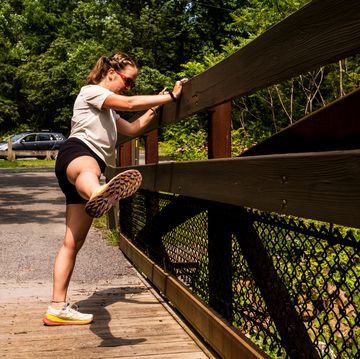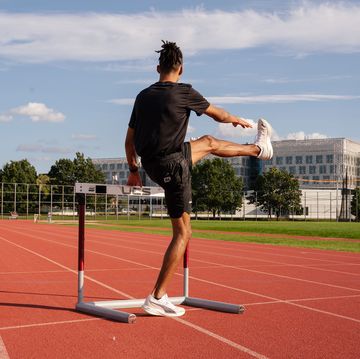We may earn commission from links on this page, but we only recommend products we back Running Times, here's a 10-minute stretching routine recommended by Phil Wharton, a musculoskeletal therapist and 2:23 marathoner. Do these stretches in the prescribed order several times a week after your runs or in the evening when you're in front of the television. The key is never to hold any stretch. Instead, you should move until you feel the resistance, back off immediately and then repeat.
1. Hamstrings
Getting the hamstrings first is important, Wharton says, because they're the anti-gravity breaking muscles that hold up the posterior side of the body. If you're sitting a lot during the day, you're turning those muscles off.
Here's what you do: Lie flat on your back with one leg stretched out in front of you and the other lifted in the air with your knee straight. Keeping your back on the floor, grab onto the raised leg behind the knee (or, if possible, by the calf) and gently pull that leg towards you. You can also use a towel or a band, instead of your bare hands, to facilitate the stretching movement.
2. Adductors
In the adductor stretch, you're bringing the exercising leg away from your midline. All you're doing, Wharton explains, is swinging your leg out and back. So lie on your back with your opposite (non-exercising) leg bent, with that foot flat on the floor. (Keeping the opposite leg bent takes the extension out of the back.) Then bring your other (exercising) leg away from your midline. In this stretch it's best to use a strap or a rope or a towel because it's nice for your outside hand to assist a little bit.
3. Abductors
The outer thigh stretch is a little more intricate, but it's great for people who have lateral hip or IT band issues, Wharton says. Your non-working leg (your opposite leg) is turned in, and that counter-balances your pelvis. So when you're stretching your right leg, keep your right leg turned out, and lead with your right heel. Use your inner leg to cross the midline of your body diagonally.
When you feel resistance, bring the leg down again immediately. That dynamic pumping action really gets the length in the muscle and relaxes the tissues.
4. Glutes
This stretch is a crossover with a bent knee: Lie on your back and bring your knee to your opposite shoulder. If you've got back soreness, Wharton advises you to keep the non-working leg bent. Otherwise, you can keep the non-working leg straight and a little bit turned in as a counterbalance for the back. So if you're on your right side, your right hand's on your outer thigh and your left hand's on your outer shin. Bring your knee to your opposite shoulder.
You may want to hold this stretch because it feels so good, but back off as soon as you feel resistance. "Be very careful the first couple of reps because you're resetting those neural pathways and you may have a lot of tension in there," cautions Wharton. "Show your body where you want it to go and then you'll see by the third or fourth rep that your body will go way past what you thought it could even do." He suggests doing eight to 10 reps on one leg, fully unlocking that side, before switching to the other leg.
5. Lower back
Try a bent-knee trunk flexion. Sit on the ground with your knees bent, your legs slightly apart, and your feet flat on the floor. Bring your trunk down, tucking your chin to your chest, so you're getting a full elongation of the back muscles while you use your abdominals to gently go forward. If you've got the range of motion, your hands can assist at your ankles. If your back is extremely tight, you could try this exercise from a chair, with your feet resting flat on the floor.
A Part of Hearst Digital Media
Dynamic moves by Phil Wharton

Watch Next

Other Hearst Subscriptions

Best Psoas Stretches for Hip Flexors

Handy Mobility Tests You Need to Try at Home

5 The Best Yoga Routine to Address Menstrual Cramps

The Best Yoga Routine to Address Menstrual Cramps
Other Hearst Subscriptions
Other Hearst Subscriptions







